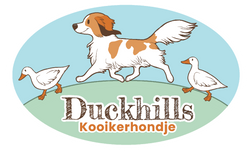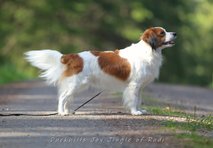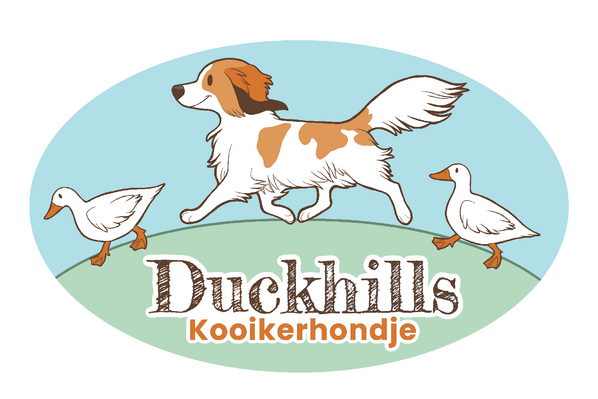Duckhills
het Nederlandse Kooikerhondje
SVENSK:
Rasen är en alert, aktiv och intelligent hund med ett gladlynt temperament och är mycket lättlärd.
Kooikerhondje utvecklar ofta starka personligheter med mycket charm och blir en älskad, trogen familjemedlem. Den är mycket hund i sin lilla storlek och kräver en ägare som är tydlig och konsekvent för att den ska kunna formas till den följsamma, trevliga hund den är. Den är mycket lyhörd och reagerar snabbt vilket man ska utnyttja då man fostrar och aktiverar den.
Skötsel
Pälsen är lättskött och kräver nästintill ingen skötsel, enstaka tovor bakom öronen. Normal rengöring med bad och schampo vid behov. Den fäller sin päls så som långhåriga hundar gör, oftast vår och höst. Pälsen luktar sällan blöt hund och är relativt lätt att borsta bort från kläder. I övrigt är det kloklippning och daglig omsorg såsom alla djur kräver.
Hälsa och sjukdomar
Kooikern är en relativt frisk ras utan någon specifik belastning av sjukdomar. Genom den unika stamboken, vilken omfattar alla individer som är födda i världen sedan 1942, har vi ett bra verktyg för att kunna undvika många sjukdomar.
Innan avel så rekommenderas att individen är ögonlyst, patellaundersökt och DNA-testad för von Willbrands sjukdom alternativt av SKK klassade som hereditärt fri från sjukdomen.
Von Willebrand är en blödarsjuka som upptäcktes 1991 på rasen. Redan 1998 kom DNA-test och idag är sjukdomen under kontroll. Inga sjuka hundar har påträffats i Sverige.
ENM är en ärftlig nekrotiserande mylelopati med förlamning som drabbar unga hundar oftast före 8 månaders ålder.
Skaffa en Kooiker?
Om du funderar på att skaffa en Nederlandse Kooikerhondje, tänk på att:
Det är en liten hund med stor kapacitet som kräver stöd och vägledning för att utvecklas på bästa sätt
Den behöver en ägare som aktiverar den och är beredd att lägga mycket tid på den som valp och unghund.
Det är i ung ålder som grunden läggs för hur den kommer att bli som vuxen.
Den är mycket mån om att vara till lags men behöver en ägare so tydligt talar om vad som förväntas.
tekst: Skooi.se
FCI-Standard N° 314
NEDERLANDSE KOOIKERHONDJE
Origin: The Netherlands.
Date of publication of the official valid standard: 13.10.2010.
Utalization: Sporting and Companion Dog used for duck decoy.
FCI-classification
Group 8 Retrievers – Flushing Dogs – Water Dogs.
Section 2 Flushing Dogs.
Without working trial.
Brief historical summary
In 1942, during the Second World War, the Baroness Van Hardenbroek van Ammerstol began to recreate the Kooikerhondje. She gave a picture of the type of dog she was looking for to a pedlar and asked him to look out for such dogs. At a farm in the province of Friesland he found the bitch now well known as Tommy. She became the founding bitch of the Kooikerhondje. In 1966 the Raad van Beheer adopted the interim breed and in 1971 the breed was officially recognized.
The Kooikerhondje was and still is used in the duck decoys. His task is still to lure the ducks into the decoy with his gaily waving tail; he does not hunt the ducks. He calmly moves between the decoy-screens in order to provoke the ducks curiosity and lure them further down the decoy pipe where the ducks are captured in a trap. They are either killed for the table or ringed for ornithological research.
General appearance
The Kooikerhondje is a harmoniously built orange-red parti-coloured small sporting dog of almost square body proportions. He moves with his head held high; in action the well-feathered waving tail is carried level with, or above the topline. The ears have black hair at the tip, the so-called earrings. The dog is presented with a natural, untrimmed coat.
Important proportions
The length of the body from the point of the shoulder (at the scapula/humerus) to the point of the buttocks may be slightly longer than the height at the withers. Skull and muzzle are of about equal length.
Behaviour and temperament
Lively and agile, self-confident and with sufficient perseverance and stamina, good natured and alert, however not noisy. The breed is faithful, easy-going and friendly.
Outside the hunting season the dog is expected to find and kill vermin, hence he needs to be keen, swift and tough. He is a true sporting dog, being attentive and energetic and having a zest for working and with a cheerful character.
Head
The head is of moderate length, fitting in with the general appearance, clean-cut, with flowing lines.
Cranial region
Skull: Sufficiently broad, moderately rounded.
Stop: Seen in profile clearly visible but not too deep.
Facial region
Nose: Black and well developed.
Muzzle: Seen from the side not too deep and slightly wedge-shaped; seen from above not tapering too much and well-filled under the eyes.
Lips: Preferably well-pigmented, close-fitting and not overhanging.
Jaws / Teeth: Scissor bite; complete dentition is desirable. Pincer bite is accepted but less desirable.
Eyes: Almond-shaped, dark brown with a friendly, alert expression.
Ears: Moderately large, set on just above the line from the point of the nose to the corner of the eye. The ears are carried close to the cheeks without a fold. Well feathered; black hair tips (“earrings”) are highly desirable.
Neck
Strongly muscled, of sufficient length and clean-cut.
Body
Topline: Smooth line from the withers to the tail.
Back: Strong and straight, rather short.
Loin: Of sufficient length and width, strongly muscled.
Croup: Slightly sloping and sufficiently broad; the length of the croup should be 1.5 times the width.
Chest: Reaching to the elbows with sufficient spring of ribs. Sufficiently developed forechest.
Underline and belly: Slight tuck-up towards the loin.
Tail
Set on so as to follow the topline of the body, carried level with the topline or almost straight up (gaily). Well-feathered with a white plume. The last vertebra should reach the hock joint.
Limbs
Forequarters
Shoulder: Shoulder sufficiently sloping in order to create a flowing line from neck to back.
Upper arm: Well-angulated towards shoulder blade that is of equal length.
Elbow: Close to the body.
Forearm: Straight and parallel, strong bone of sufficient density and length.
Metacarpus (Pastern): Strong and slightly oblique.
Forefeet: Small, slightly oval, compact with well-knit toes pointing forward.
Hindquarters
General appearance: Well angulated, straight and parallel seen from the rear. Strong bone.
Tigh: Well muscled.
Lower thigh: Length equal to thigh
Hock joint: Well let down.
Hind feet: As forefeet.
Gait/movement
Should be flowing and springy, well extended, with good drive. Limbs parallel.
Coat
Hair
Of medium length, slightly wavy or straight and close lying. Soft hair. Well-developed undercoat.
Front legs should have moderate feathering reaching to the pastern joints. Hind legs should have fairly long feathered breeches; no feathering below the hock joints. The coat on the head, the front part of the legs and the feet should be short. Sufficiently feathered on the underside of the tail. Longer hair on throat and forechest. Earrings (long feathered black hairtips) are highly desirable.
Colour
Distinct patches of clear orange-red colour on pure white although a few small spots on the legs are accepted. The orange-red colour should be predominant. Some black hair intermingling with the orange-red colour and a slight form of ticking are accepted but less desirable.
Colouring on the head
A clearly visible blaze running down to the nose. There should be colouring on the cheeks and around the eyes. A blaze that is too narrow or too wide or only partly coloured cheeks is less desirable. A black tail ring where the colour changes from orange-red to white is permitted.
Size
Ideal height at the withers: Males: 40 cms.
Females: 38 cms.
Tolerance: 2 cms over or 3 cms under the ideal heights are permitted.
Faults
Any departure from the foregoing points should be considered a fault and the seriousness with which the fault should be regarded should be in exact proportion to its degree and the functional health and welfare of the dog and on its ability to perform its traditional work.
Ears too small.
Ears half-erect, “flying ears”.
Tail that is curled.
Hackney gait.
Curly or silky hair.
Colour that is heavily interspersed with black hairs in the orange-red patches.
Too much ticking.
Over maximum size or under minimum size.
Severe faults
Anxious behaviour.
Distinctly low on legs, out of proportion.
Wall eye.
Undershot or overshot bite.
Tail too short, not reaching hock-joint.
White colour on ears, partly or completely.
White hair around eyes, one or both.
Disqualifying faults
Aggressive or overly shy.
Any dog clearly showing physical or behavioural abnormalities shall be disqualified.
Colour that is black and white or tricolour.
N.B.: Male animals should have two apparently normal testicles fully descended into the scrotum.


